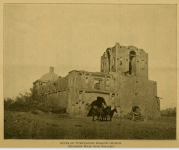Old Bookaroo
Silver Member
- Dec 4, 2008
- 4,318
- 3,510
ANCIENT RECORDS REFER
TO LOST MINES IN ARIZONA.
The following document, found in the ancient archives, is a translation from the original manuscript owned by Don Ricardo Ortiz, of Hermosillo, Mexico, of lost mines and treasures in southern Arizona:
"In the years of 1508 and 1648, -- says the account, -- the mine called the "virgin Guadalupe", belonged to the Tumacacori. It measured one league from the big gate of the Temple to the south and to the left, and from the waters of the San Ramon springs it measured 1800 varas (33 inches to a vara) to the north; and about 200 varas before arriving at the mine there is a black rock marked with a chisel with these marks, on the under side of the stone, 200 varas from the Cross of Christ is the treasure. About 20 varas from the treasure is a small monument. In a southernly direction to the west there are two peaks torn down without any other assistance than the powder being placed in the cliffs. The signs remain blotted out. People could pass over these rocks treading on the values and never see them.
"The spore [?] is composed of 50 varas square covering up the treasure on the inside and outside of the mine. Silver and gold. Virgin silver. The gold was brought from the mountains of the Guachapa (the Santa Rita mountains). 2,050 burro loads of white silver, 905 loads of gold and silver. The total value of the gold and silver amounts to $45,000,000 (forty-five million dollars).
The Tunnel of the Pure Conception.
"Follow straight ahead through the Pass of the Lost Hermanos to the south about three leagues from the Guadalupe mine is a gate called ?The Gate of the Deep Waters.? To the south from the gateway runs a creek that empties into the Santa Cruz river. The mine is to the left of the gateway. Below the gateway there are 12 arrastras and 12 patios. There is a tunnel 300 varas [from there? away?] and it has the name of ?the Pure Conception? stamped with a chisel. The tunnel runs to the north and at about 200 varas a small tunnel 100 varas long leads from the main tunnel to the west. The metal is yellow and is one-half silver and one-fifth gold.
"Fifty varas from the gate of the mine in a southerly direction will be found slabs of virgin silver (three to five loads), weighing from 25 to 250 pounds.
"This mine is covered or hidden by a gate of pure copper and has enormous iron handles.
The Mine Opeta
"From the mine of the Pure Conception to the mine of Our Lady of Guadalupe, there are three leagues. Half way in the direction is the mine called 'Opeta.' This mine has a runnel 400 varas long running to the south. The metal of this mine is in a lime contact, or rather a caliche. At about 300 varas from the mount of the tunnel they began to cut pure silver. From the mouth of this mine runs a large mesa in the direction of the setting sun. On the side of the setting sun there is a large canyon that has a landslide and a bar of black rock one-half vara thick. From the Opeta it is a league to the Tumacacori.
The Mine Tumacacori
"This mine is to the west of the other side of the mountain. In this mine is stamped "P. S. R.," the 8[SUP]th[/SUP] of February, 1508 [presumed Old Style]. This mine was found by chance. Al the interests? of Our Lady Guadalupe remain in the charity of this mine, Tumacacori. There is a covered box that has a key, and in one corner there is a screw. Take out the screw and there is an iron bar. There will be found all the maps of the great treasure.
The Mine San Pedro
"The mine called "San Pedro," is a league from the Isabella. The Isabella is along some little black hills at the foot of the mountain. There is a river to the north one-half league. From the Isabella starts a road to the San Pedro, which is a league and half from the side of the Temple to the west, and when the sun is rising is [sic - it?] strikes in the gates of the mine.
The Lady of Guadalupe Mine.
"From this mine, San Pedro, it is a league to the Guadalupe. At the San Pedro the rocks are rolled to the canyon and there is a bar of black rock one-half vara wide. The rock or bar runs around the canyon; thence the trail descends to the mind, Our Lady Guadalupe and follows the Idols of San Ramon. These idols are engraved in the rock. Enormous slabs of silver are in the San Pedro mine. The mine has a wooden gate on the west side. In the mine there are bars and deposits containing virgin silver."
Arizona Mining Journal [Phoenix, Arizona]15 February 1925 (Volume 8, No. 18)
The article is unsigned. Probert credits it to John Riggs (editor?).
----- o0o -----
Editor's Notes:"spore?" I have been unable to locate a definition of this word in a mining context. Perhaps the writer uses it as a synonym for
"goal" - the object sought in the hunt.
"Patios" - Refers to the locations used for the "patio process" of reducing ore.
I find the description of signs "blotted out" somewhat confusing. If the signs are not visible, how did the writer know they are there? And why is it surprising that people walking near them wouldn't see them if they have been hidden?
?Quien Sabe?
----- o0o -----
Good luck to all,
The Old Bookaroo
Amazon Forum Fav 👍
Attachments
Last edited:






